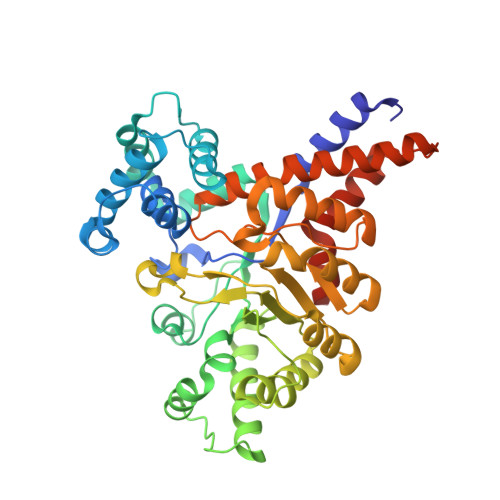The mechanism of the reaction catalyzed by uronate isomerase illustrates how an isomerase may have evolved from a hydrolase within the amidohydrolase superfamily.
Nguyen, T.T., Fedorov, A.A., Williams, L., Fedorov, E.V., Li, Y., Xu, C., Almo, S.C., Raushel, F.M.(2009) Biochemistry 48: 8879-8890
- PubMed: 19678710
- DOI: https://doi.org/10.1021/bi901046x
- Primary Citation of Related Structures:
3HK5, 3HK7, 3HK8, 3HK9, 3HKA - PubMed Abstract:
Uronate isomerase (URI) catalyzes the reversible isomerization of D-glucuronate to D-fructuronate and of D-galacturonate to D-tagaturonate. URI is a member of the amidohydrolase superfamily (AHS), a highly divergent group of enzymes that catalyze primarily hydrolytic reactions. The chemical mechanism and active site structure of URI were investigated in an attempt to improve our understanding of how an active site template that apparently evolved to catalyze hydrolytic reactions has been reforged to catalyze an isomerization reaction. The pH-rate profiles for k(cat) and k(cat)/K(m) for URI from Escherichia coli are bell-shaped and indicate that one group must be unprotonated and another residue must be protonated for catalytic activity. Primary isotope effects on the kinetic constants with [2-2H]-D-glucuronate and the effects of changes in solvent viscosity are consistent with product release being the rate-limiting step. The X-ray structure of Bh0493, a URI from Bacillus halodurans, was determined in the presence of the substrate D-glucuronate. The bound complex showed that the mononuclear metal center in the active site is ligated to the C-6 carboxylate and the C-5 hydroxyl group of the substrate. This hydroxyl group is also hydrogen bonded to Asp-355 in the same orientation as the hydroxide or water is bound in those members of the AHS that catalyze hydrolytic reactions. In addition, the C-2 and C-3 hydroxyl groups of the substrate are hydrogen bonded to Arg-357 and the carbonyl group at C-1 is hydrogen bonded to Tyr-50. A chemical mechanism is proposed that utilizes a proton transfer from C-2 of D-glucuronate to C-1 that is initiated by the combined actions of Asp-355 from the end of beta-strand 8 and the C-5 hydroxyl of the substrate that is bound to the metal ion. The formation of the proposed cis-enediol intermediate is further facilitated by the shuttling of the proton between the C-2 and C-1 oxygens by the conserved Tyr-50 and/or Arg-355.
Organizational Affiliation:
Department of Chemistry, P.O. Box 30012, Texas A&M University, College Station, Texas 77842-3012, USA.


















